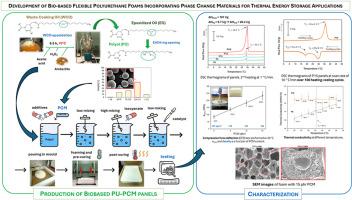Development of bio-based flexible polyurethane foams incorporating phase change materials for thermal energy storage applications
IF 7.9
3区 材料科学
Q1 GREEN & SUSTAINABLE SCIENCE & TECHNOLOGY
引用次数: 0
Abstract
The fabrication of innovative polyurethane panels for energy efficiency is increasingly important and should ideally be based on sustainable, non-fossil-based feedstock. In this context, the present work reports the development of sustainable composite panels by incorporating microencapsulated phase change materials (PCMs) into flexible polyurethane (PU) foams, synthesized from a polyol derived from waste cooking oil (WCO) and a partially bio-based isocyanate. The PU-PCM panels achieved energy storage capacity up to 26.2 J/g at a maximum PCM content of 15 phr. Uniform PCM dispersion slightly reduced cell size and increased panel density (from 128 to 157 kg/m3), thereby enhancing structural support and rigidity while reducing elasticity (compression force deflection up to 234.8 kPa). Fatigue tests confirmed resistance to cyclic loading, with increased dynamic stress and stiffness due to PCM integration. Differential scanning calorimetry showed minimal enthalpy hysteresis (±0.26 J/g) and a stable phase-change temperature (36 ± 0.1 °C), demonstrating resilience to thermal and mechanical stress. Thermal conductivity increased slightly (from 46.15 to 48.44 mW/m·K at 20 °C) due to the silica-based PCM shell, while thermal diffusivity decreased, favouring transient thermal regulation. Fire performance remained unaffected, likely due to the balance between the flammable paraffinic core and the flame-retardant silica shell of PCMs. Overall, bio-based PU-PCM panels show potential for transportation and construction applications owing to their lightweight, insulating, and flame-retardant properties. They offer improved sustainability and thermal-mechanical performance compared to conventional PU panels and flammable PCMs, while supporting circular economy principles by valorising end-of-life WCO.

结合相变材料的生物基柔性聚氨酯泡沫的研制
为了提高能源效率,创新聚氨酯板的制造变得越来越重要,理想情况下,应该基于可持续的非化石原料。在此背景下,本工作报告了可持续复合板的发展,通过将微胶囊化相变材料(PCMs)纳入柔性聚氨酯(PU)泡沫中,由废食用油(WCO)衍生的多元醇和部分生物基异氰酸酯合成。在最大PCM含量为15 phr时,PU-PCM面板的储能容量高达26.2 J/g。均匀的PCM分散稍微减小了电池的尺寸,增加了面板密度(从128 kg/m3增加到157 kg/m3),从而增强了结构的支撑力和刚性,同时降低了弹性(压缩力挠度高达234.8 kPa)。疲劳测试证实了对循环载荷的抵抗,由于PCM集成而增加了动态应力和刚度。差示扫描量热法显示最小的焓滞(±0.26 J/g)和稳定的相变温度(36±0.1°C),显示出对热应力和机械应力的弹性。由于硅基PCM外壳的存在,导热系数略有增加(在20°C时从46.15 mW/m·K增加到48.44 mW/m·K),而热扩散率下降,有利于瞬态热调节。防火性能没有受到影响,可能是由于pcm的易燃石蜡芯和阻燃硅壳之间的平衡。总体而言,生物基PU-PCM面板由于其轻质、绝缘和阻燃特性,在运输和建筑应用中显示出潜力。与传统的PU面板和可燃pcm相比,它们提供了更好的可持续性和热机械性能,同时通过提高寿命终止的WCO来支持循环经济原则。
本文章由计算机程序翻译,如有差异,请以英文原文为准。
求助全文
约1分钟内获得全文
求助全文
来源期刊

Materials Today Sustainability
Multiple-
CiteScore
5.80
自引率
6.40%
发文量
174
审稿时长
32 days
期刊介绍:
Materials Today Sustainability is a multi-disciplinary journal covering all aspects of sustainability through materials science.
With a rapidly increasing population with growing demands, materials science has emerged as a critical discipline toward protecting of the environment and ensuring the long term survival of future generations.
 求助内容:
求助内容: 应助结果提醒方式:
应助结果提醒方式:


